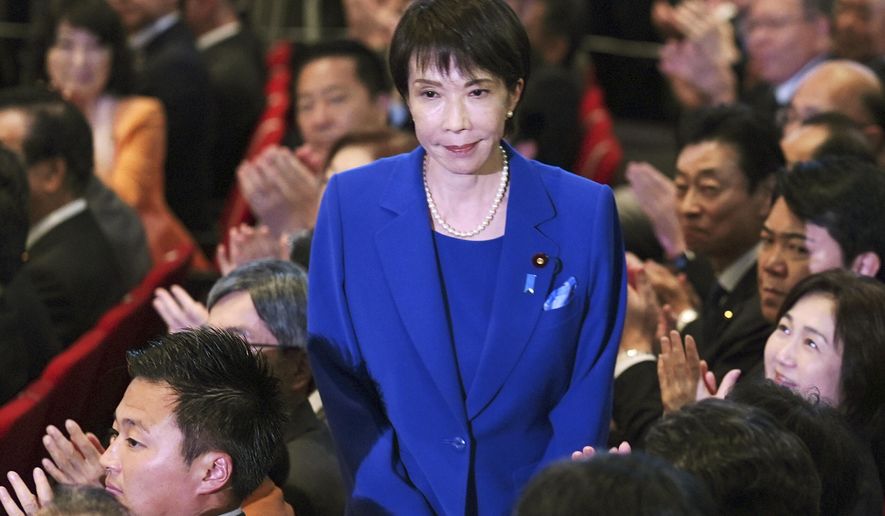A version of this story appeared in the daily Threat Status newsletter from The Washington Times. Click here to receive Threat Status delivered directly to your inbox each weekday.
OPINION:
The sun is rising again over “The Land of the Rising Sun.” The impending elevation of 64-year-old Sanae Takaichi to the leader of Japan signals a rightward shift in a society that is increasingly restive under the constraints of 80 years of peace enforced by a constitution that outlaws going to war again.
It’s not that Ms. Takaichi is about to become the first female prime minister in an irredeemably male chauvinist society that’s so novel. Rather, politically, professionally and socially, the deeper significance of her election as president of the long-ruling, corrupt and divided Liberal Democratic Party, to be followed by her election as prime minister by the parliament, or Diet, is that she will be the most hawkish figure to rule Japan since the war.
We have to go back to the darkest decades of imperial Japan, led by Hideki Tojo and a coterie of fanatical militarists, to find a Japanese leader who wanted to field a large army to take on foreign powers, notably China and Russia. Ms. Takaichi will not declare war on China, which Japan defeated in the contest for the Korean Peninsula and Manchuria in 1895, or Russia, whose fleet was sunk by the Japanese navy in the straits between Korea and Japan in 1905.
Ms. Takaichi will not repeat the mistakes of those “war criminals,” but she leaves no doubt that she wants Japan to be able to stand up against its enemies if President Trump compromises with Chinese President Xi Jinping, plays nice with his buddy, North Korea’s Kim Jong-un, and leaves Japan exposed to them both.
Judging from all Ms. Takaichi has said and done in 20 years in the Diet and in positions as economic security and internal affairs minister, her outlook is in the mold of Prime Minister Shinzo Abe, with whom she was closely allied during his nearly eight years in office. Abe, assassinated in 2022, two years after stepping down, desperately wanted to get rid of the shackles of the famous Article 9 of the “peace constitution” imposed by the conquering U.S. Gen. Douglas MacArthur after World War II.
Like Abe, Ms. Takaichi reams of recovering lost glory.
The words of Article 9 are stunningly simple. Renouncing “the threat or use of force as means of settling international disputes,” it states, “the right of belligerency of the state will not be recognized.” Japan decades ago built up its navy, air force and army — all known by the euphemism Self-Defense Forces — to show it is not about to wage wars of aggression beyond the homeland. Nor has it done much outside Japan other than join in exercises with the Americans in the South China Sea and with the Americans and South Koreans in what the maps call the Sea of Japan. Koreans insist it is the East Sea, east of Korea.
If Ms. Takaichi has her way, Japan will no longer be nothing more than a supine, cooperative ally of the Americans. She may not totally get rid of Article 9, but she may at least bend it so Japanese planes and ships can operate far more aggressively than seen against the Chinese around the Senkaku Islands between China’s east coast and the southernmost Japanese prefecture of Okinawa.
Certainly, Ms. Takaichi could also adopt a far more warlike policy toward North Korea, to which Japan responds with alarm and rage whenever its dictator, Mr. Kim, orders a missile test in Japan’s direction, but does nothing to counter. Similarly, she could order Japanese ships and planes to challenge periodic Chinese encirclement of Taiwan, the independent island province the Chinese ceaselessly claim as their own.
Japan has a special affection for Taiwan, which it seized from China in 1895 and ruled until the end of World War II, 50 years later. The communists have never set foot on Taiwan, to which Chiang Kai-shek’s nationalist Kuomintang forces fled before the victory of Mao Zedong’s Red Army over the mainland in 1949.
In the tinderbox of the periphery of China, Ms. Takaichi believes she can defy China and build up the Self-Defense Forces. Her voice may get even stronger if Mr. Trump, visiting Japan and Korea at the end of this month ahead of the Asia-Pacific Economic Cooperation summit, shows signs of making a deal with Mr. Kim, compromising on America’s separate treaties with Japan and South Korea or pulling out or diminishing American strength in both countries.
Given that scenario, Ms. Takaichi symbolizes her passion for Japan’s military revival by regularly visiting the Yasukuni Shrine, which memorializes Japan’s war dead, including the late Prime Minister Hideki Tojo. As the Americans’ grip on the region loosens, Ms. Takaichi aspires to nothing less than Japan’s renaissance as a military force as strong as China and Russia.
• Donald Kirk is a former Far East correspondent for the Chicago Tribune and the old Washington Star.




Please read our comment policy before commenting.